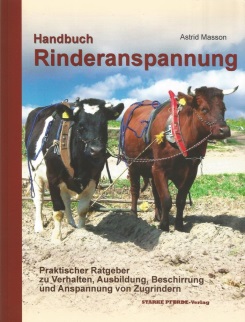– especially based on experience in open-air museums.

Astrid uses cows and their calves in her work at the Dahlem Open Air Museum in Berlin, perhaps one of the world’s only urban museums of its kind and it is indeed “open” – the public can walk through the entire farmland section without paying any entry fee, so they often just come in to watch and learn. The book is in German, with so many illustrations it is a challenge to count them.
The Handbuch provides extensive coverage of both hands-on museum practice as well as the historical background of working cattle and a thorough examination of the behavior that their human partners must be able to cope with in the context or work and the safety of museum publics. The First Part / Introduction deals with the very longue durée of human-cattle relations, the reasons for utilizing cattle in a farming economy, proper feeding and analysis of the anatomical features to be taken into account for working animals, including castration and hoof care. The Second Part / Practice guides both museum staff and farmers through the selection criteria to identify best-suited animals, how to communicate with them effectively and train them for work in the most welfare-oriented ways and expands on their behavior in work and open-air situations. The Third Part / Equipment and Harnessing Draft Cattle details their actual working performance in relation to shelter, feeding and welfare, the fine-grained details of various choices of yokes and lines, as well as hitching to implements, with a special chapter on the German 3-pad adjustable collar by expert Rolf Minhorst. The Fourth Part / Annexes provides notes on such specifics as how handlers can understand the way cattle express themselves through their eyes, face, head, horn, skin, tail and limbs (some of which may definitely surprise you!). This is followed by a rich bibliography, mainly in German and English, and the entire book is capped by a detailed index.
Cozette Griffin-Kremer (expanded version of original report in AIMA Newsletter N°5)
Astrid Masson. Handbuch Rinderanspannung. Praktischer Ratgeber zu Verhalten, Ausbildung, Beschirrung und Anspannung von Zugrindern. 202 pp. Color and b/w photographs, illustrations. Starke Pferde Verlag, 2015.
